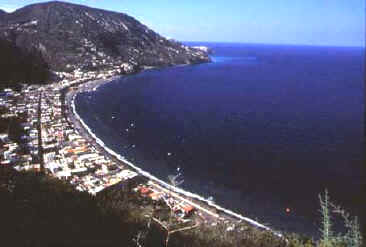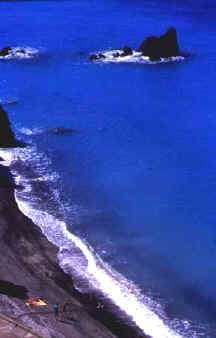

"Canneto" field

A beach of Lipari
About Lipari
| Lipari, the ancient Meligunis, is the largest island of the Archipelago, once known as the Trade Centre of Obsidian and renowned today as the main Centre for Pumice stone. The island of Lipari is the most complex from the geological and volcanogical point of view. The most ancient part is formed by the remains of stratum-volcanoes, which were to the west of the islands and make up "The Timponi", "Monterosa" etc. After the earliest period of intense eruptions, there followed a long break in the volcanic activity. In a later period we had the stratum-volcano of "Monte S Angelo". The volcanoes of the last period have erupted pumice-stones and made up a number of "cupolas", among which there is the one of "Monte Giardina". The volcanic activity started again, after a long interval, in the north-east part of the island, giving origin to lava streams of obsidian. Recent datations could establish that the latest eruption of "Monte Pelato", with the pouring forth of the obsidian flow of the "Rocche Rosse", took place about the 700 A.D. This eruption covered with a thin layer of pumice the Roman remains of IV and V centuries A.D. in locality Diana and of the Acropolis of Lipari. |
|
 "Canneto" field |
The endogenous manifestations, which one finds consist of fumaroles, solfataras and hot springs. The most important fumaroles are those of Bagno Secco; hot springs have been noted near Bagnicello, at the Fontanelle, at the Pietre di Fuardo but the most important are those of S Calogero and those which gush below Castellaro and in the proximity of the Port (Pignataro). The waters of S. Calogero have been used for therapeutic treatment since time immemorial proving themselves always to be most efficacious. At the side of the Spring rises a sweat grotto the "stufa" of Roman construction and a bath and mud installation erected in 1867. During recent works of renovation of the Spa; in proximity of the main entrance, a cupola building, included in subsequent constructions, came to light. It is a monument of civil architecture of the Mycenean civilization (Tholos) so far unknown to the Western world. The presence in the island of Lipari of a building characteristic of the Mycenean architecture, dating back to the XV century B.C., is an exceptional event of great historical interest. This discovery of the Mycenean "Tholos" confirms that during all the Bronze age, that is in the course of the I I millenium B.C., intensive culture and commerce relationships occurred between Greece and the Aeolian Islands. The analysis of the water was carried out for the first time by Arrosto in 1872; sunsequently by Gabella (1907) and lastly by Irrera and Labruto (1933). These last classified them amongst those hyper-theimal, salty - sulphate - bicarbonate - sodium with temperature varying around 60 C. |
| Lipari due to its mild climate and serene sky in Winter presents itself as an ideal resort and in Summer as a sought-after seaside resort and also for pleasure boating. This island is a centre for unforgettable excursions owing to its fascinating countryside. Interesting is the excursion to Quattrocchi where one admires, amongst a variety of colours, as in a dream, picturesque inlets with high slender rocks which reflect in the sea. In the background, as though fading away, rises from the sea the smoking Vulcano, which encloses the enchanting spectacle. It is advisable to climb M. Pelato, from where one may observe the Campo Bianco (immense, strange abyss., white as snow) and the obsidian outflows of Spanarello and Rocche Rosse. Also interesting is the climb to the suburb of Quattrocchi and to the shores at Mezzacaruso, where the imposing countryside opens up to the view: striped rocks with ruddy and yellowish tints that fall precipitously to the sea. Of great tourist interest is the boat trip around Lipari. There follow, one after the other, pictorial episodes which form a composition of great beauty and variety: deep grottos, delightful beaches, high shores, ample bays, perforated rocks, small inlets and steep, wild cliffs. |  A beach of Lipari |
|
|
The most important centre is Lipari. Part of the city extends along the two picturesque inlets of Marina Lunga and a part is distributed around its Castle (XVI century), the antique acropolis of Greek and Roman town, which rises majestically on a high Liparitic lava rock, with titanic sixteenth century bastions sheer above the sea. The Acropolis, called the Castle, is up to the present day the focus of the historical centre, where reminders of the past are still conserved. Within the perimeter of the walls, the populations of the Neolithic, those of the first half of the Iron Age (culture of Piano Quartara), the Bronze Age and the Hellenic Age had their centres as is demonstrated by archeological findings. Of the old town, besides prehistoric stratifications, there still exist Hellenistic remains, the churches and the old Episcopal palace near the Cathedral. Built by Roggero the Norman in 1084; it was completely rebuilt in the Baroque Age; it still has, of the original structure, the ogival cross vaults, valuable decorations and stuccoes of the 18th century and paintings of great artistic interest. The church of Immacolata, with its smooth facade and dark pilaster strips, the church of Addolorata of medieval origin but with a cylindrical little dome and baroque facade and the church of S. Maria delle Grazie with a 18th century facade, have all valuable architectures. Among the works of art we must point out a picture of the Addolorata, in the church of Addolorata and other paintings by Girolamo Alibrandi. |
| The walls, built by the Spaniards in the 16th century, the imposing fortifications of the 16th century are well preserved; they were built to the South and include previous fortifications of the 13th century with sheer defence towers and one tower, part of the Greek wall, which still has 23 rows of square blocks of the same thickness. From this gate·tower and through a passage with ogival gate you approach from the city to the wide area of the Castle. At the beginning of our century, a gash made in the wall has interrupted the Spanish fortifications (thus destroying part of the prehistoric and classical remains) in order to create a direct passage from via Garibaldi to the Cathedral. The Greek necropolis of Lipari extends in the plain of Diana between the Ponte valley and the Santa Lucia valley to the North. This district is superimposed on a vast prehistoric settlement which flourished from the end of the Middle Neolithic to the Early Bronze Age, but in which the maximum intensity of life occurred in the superior Neolithic age, that is the cultural period which throughout the whole of Italy is today known by this name (Diana culture). |
|
|
|
The classic Necropolis is one of the richest in Sicily. During the last twenty years systematic excavations have recovered items from more than 1,300 tombs, now exhibited in the Aeolian Museum. The most antique date from the VI century B.C., to the decades following the Greek Lipari, and present Corinthian ceramics, green painted attics and of other Grecian fabrication. Particularly rich are the tombs of the V and VI and the beginning of the III century B.C. with internments with sarcophogus in earthenware, crude bricks or stone or even by cremation, in some of which have been found large bowls and other figured vases of the red figured style or of that called Gnathia and most valuable figured earthenware of which those of a theatrical subject are particularly important. Poorer and almost always with a tile covenng are the Hellenistic tombs following the destruction of the year 251 B.C. |
| The tombs of Roman Age 1st century BC.- (II century B.C) are rich in bronze, glass and figured bronze oil lamps. In the area of the Necropolis and precisely at the beginning of the carriageable road to Piano Conte, in the vicinity of the scholastic centre are two large funerial hypogeums of the Imperial Roman Age (II century B.C.) and at least another similar one is in the grounds of the Bishop's refectory where there are also remains of other funerial monuments of later age (IV - V century B.C.). The Necropolis extended beyond the urban area of the antique city, which did not much exceed the present extent, as is shown by the recent discoveries of the city walls of the IV century B.C. which are at present being excavated. In the S. Nicola Church beyond Portinenti, one sees an architrave composed of an architectural fragment of the Classic age. Here has come to light a hypogeum similar to those discovered at Diana. At Piano Conte, an extensive plateau dotted with farmhouses, have been found axes, lavic stone hatchets and pointed asps of the late Neolithic age and of the first phases of the Metallic age. Near the Terme of San Calogero, were seen in the XVIII century the remains of Romans buildings. In the locality known as Bruca, there have been found clay vases, bowls and figures of the Greek times. |
|
|
Antique ceramic ware has been found in the area called Palmeto. Among the lithoid products, the pumice stone is the only material still exploited after the caolin deposits of Bagnosecco had been abandoned. It is a volcanic product of the acid magmas and its mass is very porous and light. In the Neolithic, around 4000 B.C., the first populations which inhabited the island started with the exploitation and commerce of a product still very much in demand: obsidian. It is a glass of volcanic origin, hard and brittle, which can flake like flint employed in the Neolithic in the human lithic industry; it has the same chemical composition of pumice stone and differentiates from the latter for its structure and macroscopic characters such as colour, specific weight, etc. The populations established in locality Castellaro Vecchio, employed the obsidian of Pomiciano, a prehistoric outflow, subsequently covered by pumice stones, thrown out Monte Pelato. These populations had been working obsidian for centuries, exporting it to all the Mediterranean basin. The mining activity and commerce started to decline after the tremendous progress of the metal technique at the beginning of the 2nd millenium B.C. The pumice deposits of Lipari spread out along the eastern and northern coasts, between the centres of Canneto and Acquacalda, for a total of 8,4 Km (over 22% of the total surface of the island); they also constitute the greatest part of Monte Pelato (m 476), of Monte Chirica (m 602) of Forgia Vecchia and in less quantity of Monte S. Angelo (m 594). |
| The craters of Forgia Vecchia and Monte Pelato have also thrown out outflows of obsidian; the Rocche Rosse one, thrown out Monte Pelato, after overcoming the barrier of the pumice stratum, outflowed on the coast forming a small promontory, Castagna point. The pumice stone of Campobianco is supposed to have been thrown out the crater of Monte Pelato; its various eruptions had also probably covered Monte Chirica. The most exploited pumice deposits are those of Campobianco and Monte Chirica; the manufacturing is carried out at the factories of Porticello where various types of pumice stone are obtained, in pieces or powder, for commercial use. |
|